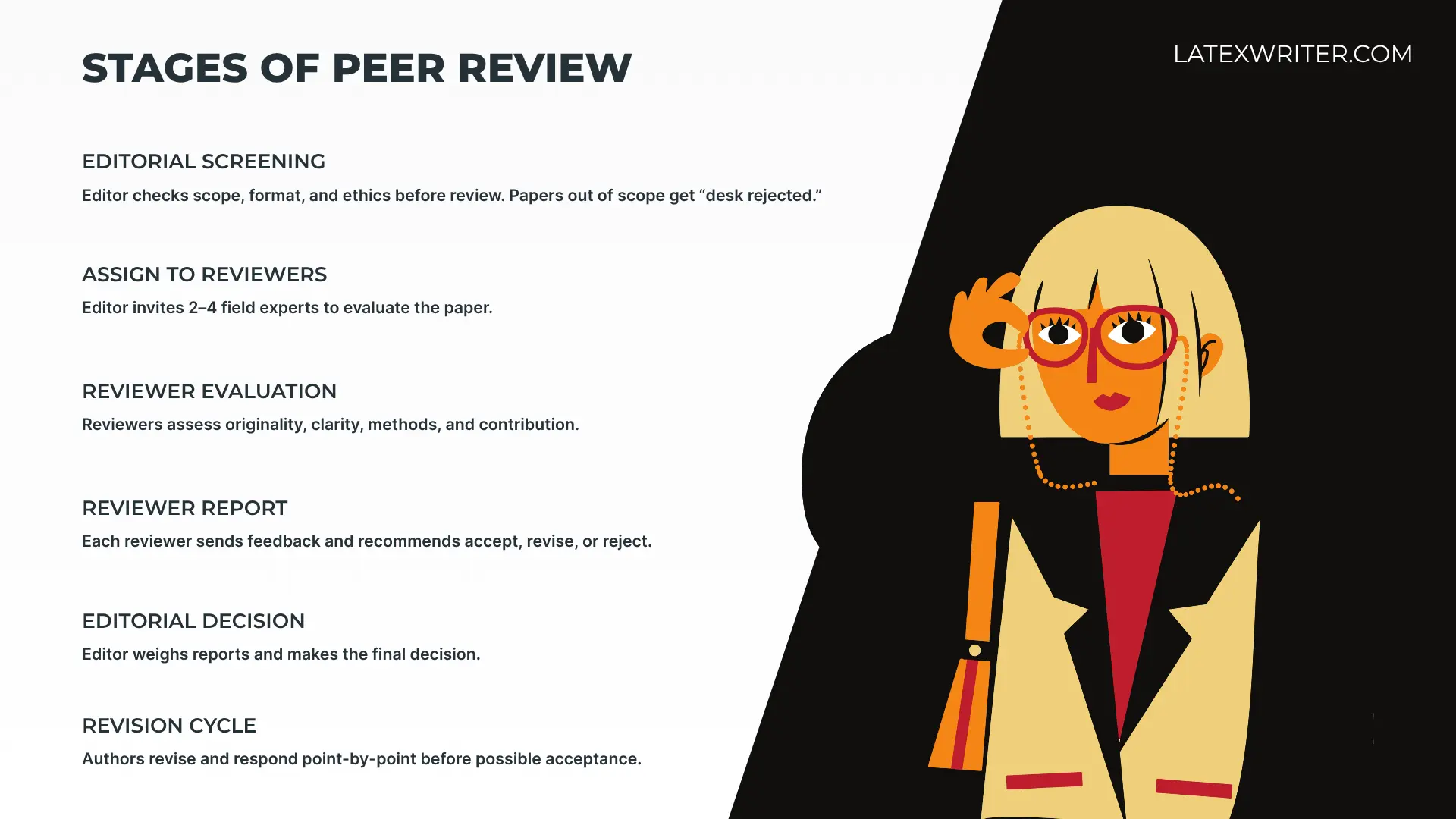Peer Review Process – What Reviewers Look For
Written by LaTeX Writer Official on Oct 6, 2025
If you are submitting your research paper to a reputed journal or conference—whether it's Scopus-indexed, IEEE, or Springer—you will go through the peer review process. This process can feel intimidating at first, but understanding it deeply will help you prepare your manuscript in a way that stands out positively to reviewers. Think of peer review as a quality check, where experts in your field evaluate your work before it gets published.
In this article, we will break down the peer review process step by step, explain what reviewers actually look for, and show you how to prepare so your paper survives review with minimal revisions.
What is Peer Review?
Peer review is the process where independent experts in your research area critically evaluate your work. Their role is to ensure that:
- The research is original and contributes something meaningful.
- The methodology is sound and replicable.
- The results are valid and not misrepresented.
- The paper is clear, structured, and free from ethical issues like plagiarism.
Journals like IEEE Transactions or Springer Journals often have rigorous multi-round peer review processes because their reputation depends on publishing only high-quality work.
A Brief History of Peer Review
Peer review didn’t appear overnight—it evolved gradually over centuries. The first scientific journals emerged in the 17th century, such as Philosophical Transactions of the Royal Society (1665), which marked the birth of modern scholarly publishing. Early editors decided what to publish, often consulting colleagues informally.
By the 18th and 19th centuries, journals began sending submissions to external experts for feedback—a practice that slowly turned into formal reviewing. In the 20th century, this became the standard. A famous moment came in 1936, when Albert Einstein had a paper reviewed by an anonymous referee at Physical Review, setting a strong precedent for external peer evaluation.
By the 1970s, major publishers like Nature and Science made peer review mandatory. Since then, it has become the global benchmark for credible research publication.
Why Peer Review Matters
The purpose of peer review is to maintain trust, quality, and credibility in research. It acts as both a filter and a guide—rejecting weak or misleading work, while helping good papers improve before publication.
Here’s why it’s so important:
- Quality Control: Peer review catches errors, flawed methods, or exaggerated claims before they reach the public.
- Credibility: A peer-reviewed paper carries authority because experts have verified it.
- Improvement: Reviewers give detailed feedback, helping authors strengthen arguments, fix weaknesses, and refine their presentation.
- Academic Integrity: It discourages plagiarism, data fabrication, and unethical research practices.
Peer review is the backbone of scholarly communication. Without it, anyone could publish anything, and readers would have no way to tell reliable research from false claims.
How Peer Review Works

The peer review process generally follows these stages:
- Submission: The author submits their paper to a journal.
- Editorial Screening: The editor checks if the paper fits the journal’s scope and meets basic quality standards. If not, it’s desk rejected.
- Assignment to Reviewers: If approved, the paper is sent to two or more expert reviewers.
- Reviewer Evaluation: Each reviewer assesses the paper for originality, clarity, soundness, and significance.
- Reviewer Report: They submit recommendations—accept, minor revision, major revision, or reject.
- Editorial Decision: The editor considers reviewer feedback and decides whether the paper moves forward.
- Revision Cycle: Authors revise their paper based on the comments and resubmit. Sometimes multiple rounds are needed.
- Publication: Once the paper meets all requirements, it’s published for readers worldwide.
This process may sound long, but it’s what ensures published research is reliable, reproducible, and valuable.
Stakeholders in Peer Review
Peer review involves several key players:
- Authors: They write and submit the research, respond to feedback, and make revisions.
- Reviewers: Independent experts who evaluate the work’s quality, originality, and rigor.
- Editors: They manage the entire process—select reviewers, interpret reports, and make final decisions.
- Readers and the Research Community: They rely on peer review to trust what they read and cite.
Each group plays a role in keeping the academic ecosystem honest and self-correcting.
Stages of Peer Review
Let's go through the stages of peer review so you know exactly what happens once you hit "submit."
- 1. Editorial Screening: The editor-in-chief or handling editor checks if your paper fits the scope of the journal/conference. If not, it is rejected without review (called a "desk rejection").
- 2. Assignment to Reviewers: If it passes the initial check, the editor sends it to 2–4 reviewers who are experts in your area.
- 3. Reviewer Evaluation: Each reviewer evaluates your paper based on originality, clarity, methodology, and significance.
- 4. Reviewer Report: They give feedback and a recommendation—accept, minor revision, major revision, or reject.
- 5. Editorial Decision: The editor considers reviewer comments and makes the final call.
- 6. Revision Cycle: If revisions are requested, you must respond carefully to each reviewer comment.
What Reviewers Look For
Now the crucial question: what exactly do reviewers look for when they read your paper? Understanding this is the difference between rejection and acceptance.
1. Originality and Novelty
Reviewers want to know: Is this research new, or is it just repeating existing work? You must clearly show what gap in the literature your work is filling. A paper that doesn't contribute anything new will likely be rejected.
2. Clear Research Problem
Your introduction should make it obvious what problem you are solving and why it matters. Reviewers dislike vague research questions or objectives that are not well defined.
3. Sound Methodology
This is one of the most critical areas. Reviewers will ask:
- Is the method appropriate for the research question?
- Are experiments, simulations, or surveys well designed?
- Can someone else replicate the study based on your description?
If your methodology is weak, reviewers will almost certainly reject your paper.
4. Valid Results and Analysis
Results should be presented clearly with correct analysis. Reviewers check if:
- Statistical tests are appropriate and correctly applied.
- Graphs and tables support claims instead of confusing readers.
- You avoid exaggeration or drawing unsupported conclusions.
5. Quality of Writing and Structure
A poorly written paper frustrates reviewers. They look for:
- Logical flow (IMRaD structure: Introduction, Methods, Results, Discussion).
- Concise writing without unnecessary jargon.
- Proper grammar, sentence clarity, and paragraph structure.
6. Ethical Standards
Reviewers are very strict about ethics. They will check for:
- Plagiarism (even accidental, through improper citation).
- Data fabrication or manipulation.
- Compliance with ethical approval (for human/animal studies).
7. Proper Referencing
Reviewers notice if you cite outdated or irrelevant sources. They expect:
- Recent and authoritative references (preferably from Scopus, IEEE, or Springer).
- Balanced coverage of related work (not just citing your own work).
- Correct formatting according to the journal style (APA, IEEE, MLA, etc.).
8. Contribution and Impact
Finally, reviewers ask: So what? Why does this work matter? A paper that solves a meaningful problem or pushes forward the field is much more likely to be accepted.
How to Prepare for Peer Review
To increase your chances of success, prepare your paper as if you were the reviewer. Ask yourself:
- Have I clearly stated the problem and solution?
- Would another researcher be able to replicate my methods?
- Have I addressed limitations honestly?
- Are all my claims backed by data?
- Have I proofread carefully for clarity and formatting?
Responding to Reviewer Comments
If your paper is not rejected but sent back for revision, treat it as a positive sign. Reviewers are giving you a chance to improve your work. Always:
- Address every comment one by one.
- Be polite and professional, even if you disagree.
- Explain your revisions clearly in a "response to reviewers" document.
- If you cannot make a suggested change, justify why.
Final Thoughts
The peer review process is not your enemy—it is your ally in making your research stronger. Journals like IEEE, Springer, and Scopus-indexed publications have strict standards, but they all look for the same fundamentals: originality, sound methods, valid results, clear writing, and meaningful contribution.
By preparing your paper with the reviewer's mindset, you minimize the risk of rejection and maximize the impact of your research. Remember: every round of review is an opportunity to refine your work and make it worthy of recognition in your field.
